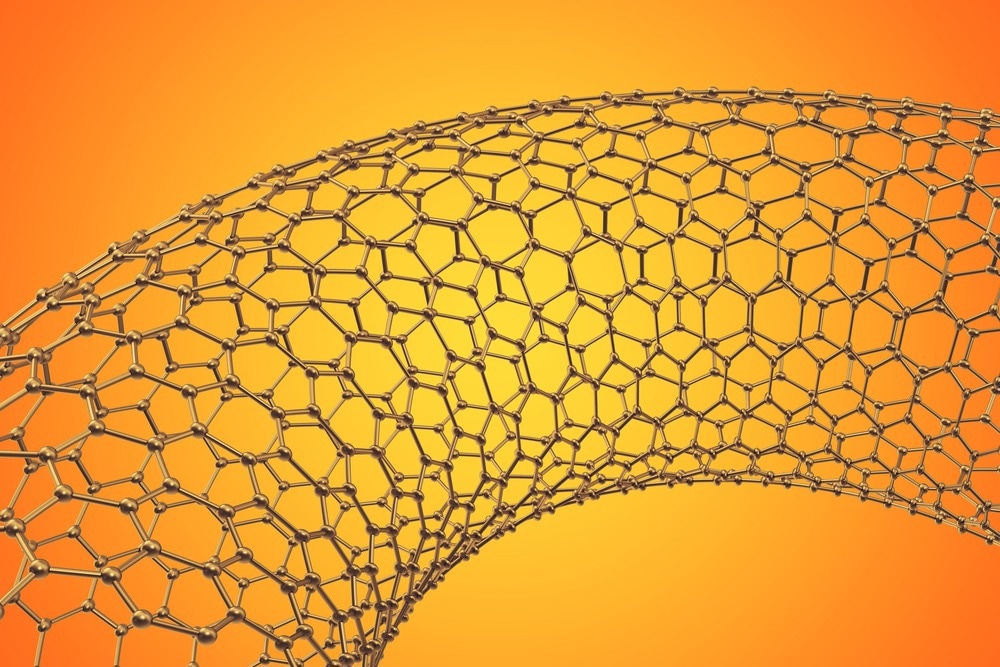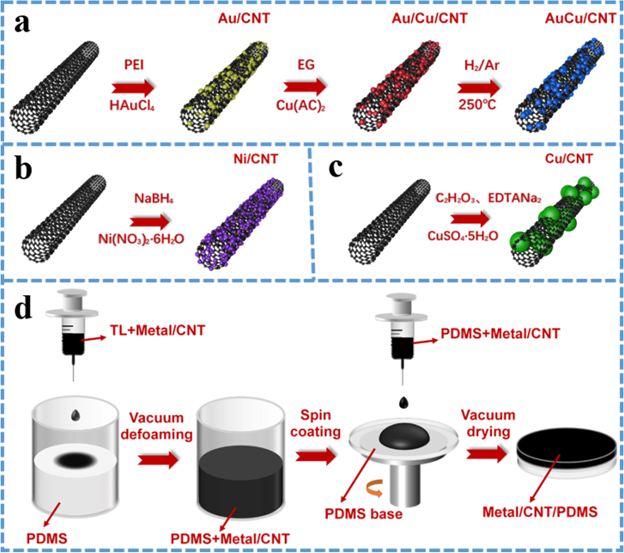Flexible conducting sheets are projected to be employed in elastic electronic equipment due to their superior conductivity and deformability. In a study published in Scientific Reports, four types of stretchable conducting sheets were created by combining metallic nanoparticles on the surface of carbon nanotubes and distributing them in a polydimethylsiloxane framework.

Study: Modeling and characterization of the electrical conductivity on metal nanoparticles/carbon nanotube/polymer composites. Image Credit: Rost9/Shutterstock.com
Maintaining Flexibility of Carbon Nanotubes
Carbon nanotubes (CNTs) are frequently employed in electronic equipment, transducers, sensors, and biomaterials due to their exceptional electrical, mechanical, and thermal characteristics. Several stretchable conducting composites based on carbon nanotubes and flexible polymers like polydimethylsiloxane (PDMS) have been thoroughly investigated.
The key to producing elastic polymeric composites with high conductivity involves developing a carbon nanotube conduction framework in a virtually insulated polymeric matrix. Upping the CNT concentration of polymeric composites may typically enhance their conductance, but it will ultimately diminish their flexibility.
Increasing the conductance of carbon nanotubes rather than increasing their quantity is a more beneficial technique for maintaining composite flexibility.
Ensuring High Conductivity of Carbon Nanotubes for Good Flexibility
Numerous studies on increasing the conductance of carbon nanotube/polymer nanoscale composites have been published thus far. Adding metallic nanoparticles (NPs) to the polymeric framework is one of the several techniques to increase the conductance of the composite.
Another viable way to increase the conductance of a carbon nanotube system is to coat it with high conductivity alloy or metal particles (like gold and copper). Unfortunately, gold is too costly for scalable usage.
On the other hand, copper is significantly cheaper, but it is tricky to regulate the size of its nanoparticles (< 50 nm) and is easily oxidized. The quantity of gold used in synthesizing gold-copper (AuCu) alloy may be lowered while maintaining the same covering proportion.
The size of nickel nanoparticles synthesized on CNTs can be precisely regulated. Only a sufficient number of metallic nanoparticles deposited on the CNT surface can guarantee good conductance of the carbon nanotube system.

Schematic diagram of (a) Au/CNT and AuCu/CNT preparation process, (b) Ni/CNT preparation process, (c) Cu/CNT preparation process and (d) Metal/CNT/PDMS films preparation process. © Wang, Y., Lu, S. et al. (2022).
Methodology of the Research
This study fused nickel, gold, copper, and AuCu alloy NPs on the surface of carbon nanotubes. The resulting metal/CNT was then disseminated in a polydimethylsiloxane matrix to create an elastic Metal/CNT/PDMS composite sheet.
X-ray diffraction (XRD), scanning tunneling electron microscopy with high-angle annular dark field testing (HAADF-STEM), scanning electron microscopy (SEM), and transmission electron microscopy (TEM) were used to analyze the microscale architecture of the specimens.
The electric conductance of the resulting composites was determined using a four-point approach. Metal/CNT/PDMS elastic sheets showed electric conductance about two orders of magnitude higher than CNT/PDMS elastic sheets.
A computational framework predicated on the Metropolis methods and percolation theory was used to investigate the effect of metallic nanoparticles on the conductance of Metal/CNT/PDMS sheets.
The main parameters influencing the conductance of the developed Metal/CNT/polymer composite were examined based on the experimental and computational findings. Furthermore, the model estimated the electrical conductance information of elastic composites by combining various metallic or alloy NPs and modifying different carbon nanotube framework characteristics.
Important Findings of the Study
By combining uniformly distributed metallic nanoparticles on the surface of carbon nanotubes, Au/CNT, Cu/CNT, Ni/CNT and AuCu/CNT were effectively produced. The findings of HAADF-STEM and XRD indicated that AuCu alloy particles with similar atomic ratios were fused on the nanotube surface.
Based on these findings, conducting elastic sheets on PDMS substrate with varied carbon nanotube loadings was produced. The findings of electric conductance tests revealed that the majority of the produced Metal/CNT/PDMS sheets possessed greater electrical conductance in comparison with CNT/PDMS sheets.
The addition of metallic nanoparticles increased the electric conductance of carbon nanotubes and the tunneling effect at nanotube intersections. As opposed to simple CNT intersections, electrons must penetrate metallic nanoparticles from the nanotube at metal/CNT interfaces and then tunnel across the polymeric insulation layer to traverse to the next nanotube.
The computational findings revealed that the inherent conductance and aspect ratio of CNTs, and the inherent conductance, size, and covering ratio of metallic nanoparticles were the primary parameters influencing the electrical conductance of the Metal/CNT/polymer sheet.
Numerical findings also revealed that the conductance of elastic composites might exceed 100 S/m in Au/CNT/PDMS, Cu/CNT/PDMS, AuCu/CNT/PDMS, Ag/CNT/PDMS, or CuAg/CNT/PDMS films when the carbon nanotube concentration is eight wt.%, covering ratio of the metallic nanoparticles is 100%, and the inherent conductance of the nanotubes is 106 S/m.
Reference
Wang, Y., Lu, S. et al. (2022). Modeling and characterization of the electrical conductivity on metal nanoparticles/carbon nanotube/polymer composites. Scientific Reports. Available at: https://doi.org/10.1038/s41598-022-14596-x
Disclaimer: The views expressed here are those of the author expressed in their private capacity and do not necessarily represent the views of AZoM.com Limited T/A AZoNetwork the owner and operator of this website. This disclaimer forms part of the Terms and conditions of use of this website.